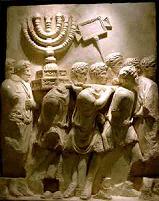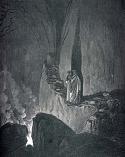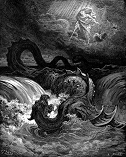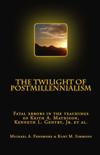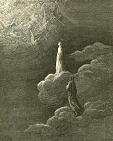The Binding and Loosing of the Great Red Dragon
and the Reign of the Martyrs
Kurt M. Simmons
The reign of the saints and binding of the Dragon is probably the most challenging passage of scripture in the Bible. The difficulty results from attempting to understand these symbols as if joined in time and event; as if one defined the other. One writer described it this way: "Satan is bound a thousand years and the saints lived and reigned with Christ a thousand years. To the degree that the Satan was bound, to the same degree the saints lived and reigned. The measure of the one is the measure of the other."[1] We would suggest, however, that the reign of the saints is not defined by the binding of the Dragon, that the two events are completely unconnected in both time and event, and that they must be analyzed separately to be correctly understood. Further, we believe that a proper analysis will show that two separate millennia are posited by the text.
The Binding and Loosing of the Dragon
What does the binding and loosing of Revelation's Great Red Dragon refer to? The basic assumption of most commentators is that the binding of the Dragon follows the defeat of the Beast and death of the martyrs; that the thousand-year binding of the Dragon is coterminous with the reign of the saints and points to the present era; that it signifies a period stretching into the indefinite future after which the Dragon will be loosed before being finally destroyed in the battle of Gog and Magog. This error completely confounds an understanding of the text. Upon it rests the belief that long ages were to pass from the defeat of the Beast and False Prophet until the second coming of Christ and the resurrection of the dead. Both A- and Post- millennialism make this basic mistake and thus introduce a complete discontinuity into the text. Although generally conceding that the new heavens and earth described in Rev. 21 and 22 are come, these schools believe that the events portrayed in Rev. 20 remain to be fulfilled:
“The specific point of the binding of the Dragon, therefore, is to prevent him from inciting the eschatological “war to end all wars,” the final battle – until God is ready. When God’s Kingdom-City is fully matured, then He will once more release Satan and allow him to deceive the nations for the final conflagration…The Dragon is not his own master. He has been seized and bound and shut up in the Abyss, and someday he will be released for a brief time – but all this takes place according to God’s good and holy purposes.”[2]
According to these schools, therefore, the whole of Revelation is fulfilled with the exception of a few verses in chapter twenty; a case of the tail wagging the dog, if ever there was one! Even among Preterists this error sometimes obtains. J. Stuart Russell, author of the Parousia, whose exegesis was otherwise usually quite sound, stumbled at the imagery of chapter twenty. He concluded that the binding of the Dragon followed the defeat of Nero and the Beast. Hence, Stuart concluded, the imagery of Rev. 20 remained to be fulfilled:
“We must consequently regard this prediction of the loosing of Satan, and the events which follow, as still future, and therefore unfulfilled. We know of nothing recorded in the history which can be adduced as in any way a probable fulfillment of this prophecy…The result of the whole is, that we must consider the passage which treats of the thousand years, from ver. 5 to ver. 10, as an intercalation or parenthesis. The Seer, having begun to relate the judgment of the dragon, passes in ver. 7 out of the apocalyptic limits to conclude what he had to say respecting the final punishment of the ‘old serpent,’ and the fate that awaited him at the close of a lengthened period called ‘a thousand years.’ This we believe to be the sole instance in the whole book of a excursion into distant futurity; and we are disposed to regard the whole parenthesis as relating to matters still future and unfulfilled.”[3]
This sort of “partial Preterism” is nothing if not A- and Post- millennialism by a different name. It is the product of a confused exegesis. The evidence is much to the contrary. The error lies in failing to see the identity of the battles of Armageddon and Gog and Magog and the belief the binding of the Dragon therefore follows the defeat of the Beast and False Prophet.
The battle of Armageddon and the battle of Gog and Magog were the same battle. The battle of Armageddon is introduced, saying unclean spirits like frogs (deceitful doctrines and slanders) went forth from the Dragon, Beast, and False Prophet to gather the kings of the earth and of the whole world to battle against Christ and the church. (Rev. 16:13-16) In consequence of this war, the Beast and False Prophet are destroyed. (Rev. 19:11-21) The imagery of the battle of Armageddon is specifically borrowed from Ezekiel's battle of Gog and Magog. (Cf. Rev. 19:17, 18; Ezek. 39:17-20) Use of the imagery from the battle of Gog and Magog to describe Armageddon establishes the identity of these battles; the battles are one and the same, only the names are different. The Dragon also meets his demise in this battle (Rev. 20:7-10), it is merely portrayed separately. Like the Great Whore, the defeat of the Dragon is treated separately for purposes of emphasis. The Dragon’s defeat is treated separately inasmuch as he is the perennial enemy of God and his people, having assumed the form of various persecuting nations over the long centuries, including Egypt, Assyria, and Babylon. (Cf. Ps. 74:14; 104:26; Isa. 14:29; 27:1,13; Jer. 51:44; Ezek. 29:3, 4; 32:2-6, where these nations are variously described as Leviathan, a serpent, or dragon.)
The identity of the battle of Armageddon and Gog and Magog is one of the keys to the binding and loosing of the Dragon. If the battles are the same with merely the names changed, identification of the battle of Armageddon will identify the battle of Gog and Magog and thus establish the time frame for the binding and loosing of the Dragon. How do we identify the historical referent of this battle? One way is to identify one of more of its participants. If the Beast or False Prophet can be identified, we will be a long way toward identifying this conflict. The Beast is widely accepted in Postmillennial and Preterist circles as Nero or the persecuting power animated by that emperor. Many Amillennialists would agree, though some feel a Domitian context is indicated. The identity of the Beast with Domitian is refuted by the pre- A.D. 70 composition of Revelation and the chronological indicators of the book showing that the sixth emperor was still reigning and that the mark of the Beast answers to the numeric value of the emperor's name, Nero Caesar.
The identity of the Beast with the persecution under Nero establishes the time frame for the battle of Armageddon/Gog and Magog. In fact, we would suggest that they are one and the same thing and that the Neronean persecution was the battle of Armageddon/Gog and Magog. Armageddon was to be the last and final battle before the great consummation. It was to precede the end and was the final crisis God's people had to face before the second coming. Christ warned his people that he would come as a thief in the events connected with that battle: "Behold, I come as a thief, Blessed is he that watcheth, and keepeth his garments, lest he walk naked, and they see his shame." (Rev. 16:15) With the battle comes a voice from the throne in heaven, saying "It is done." (v. 17) Following this crisis, Babylon the Great (Jerusalem) comes into remembrance before God. (v.19) The fact that the Beast is one of the actors in this great battle means that Nero was a participant. The fact that the battle precedes the destruction of the Great Whore means that it preceded the fall of Jerusalem. Since there is no other historical event of which Nero was part and which preceded the fall of Jerusalem, the Neronean persecution becomes the best and only solution for the identity of the battle of Armageddon.
Having identified the Beast and the battle of Armageddon with the persecution under Nero, identification of the binding and loosing of the Dragon becomes rather simple. The Dragon acts through the Beast; the Beast is the alter ego of the Dragon; the Dragon gives the Beast its seat and great authority (Rev. 13:2); those who worship and obey the Beast worship and obey the Dragon (v. 4). The Beast acts at the behest of the Dragon. While the Dragon is bound, the Beast is bound. When the Dragon is loosed, the Beast is loosed. The Beast ascends from the Bottomless Pit (Rev. 11:7; 17:8), the Dragon ascends from the Bottomless Pit. (Rev. 20:7) Since the battles are the same event under different names and symbols, the ascent of the Beast and Dragon from the Bottomless Pit are the same event under different names and symbols. The ascension of the Beast from the Bottomless Pit marks the beginning of the persecution under Nero; it also marks the loosing of the Dragon. The Beast rises from the Bottomless Pit and gathers the kings of the earth together to battle against Christ and the church in the battle of Armageddon (Rev. 11:7; 16:13, 14; 17:8); the Dragon rises from the Bottomless Pit to gather Gog and Magog to battle against Christ and the church. (Rev. 20:7-9) The battle of Gog and Magog was to occur in Israel's "latter days" (Ezek. 38:8, 16); it is depicted as a great invasion against God's people, a storm to cover the land (v. 9); it follows the appearance of "David the Prince" (Ezek. 37:25), but precedes the restored kingdom-temple (church) in which "David" the Prince would reign as king and priest. (Ezek. 40-48; cf. Zech. 6:13) Ezekiel's description shows that the battle of Gog and Magog occurs after the earthly ministry of Jesus, but before the great consummation in A.D. 70 and the coming of the kingdom in fullness of power. All this is equally true of Armageddon.
|
We said above that the loosing of the Beast and Dragon from the Bottomless Pit point to the beginning of the persecution under Nero. If loosing these powers points to their ability to persecute, what would their binding and internment in the Bottomless Pit point to but restraint from persecution? Clearly, this is so. The Beast ascends from the Bottomless Pit to make war upon the saints. (Rev. 11:7; 17:8) While it is in the Pit it is prevented to persecute. Only when it is released is it able to raise again the persecution of the church. Hence, the Bottomless Pit points to the cessation of persecution; it points to the wounding of the Beast's head (Rev. 13:3), to the defeat of the persecuting power and its consignment to oblivion in a symbolic tartarus. Rising from the Pit points to the healing of the Beast's wound (Rev. 13:3); its recovery from defeat and ability to raise again the persecution of the church. If the persecution under Nero marks the loosing of the Dragon (and Beast), its binding must point to a referent earlier in time and event.
The two persecutions in Revelation occur in chapters twelve and thirteen. Luke records a persecution early in the history of the church that arose over Stephen. (Acts 7:59-9:31) History tells of a second persecution under Nero. The binding of the Dragon (and Beast) therefore came between these two persecutions. The persecution that arose over Stephen collapsed by A.D. 38 when Paul converted to the faith. Pilate and Caiaphas were removed from power shortly before this (A.D. 36-37). From A.D. 42 to A.D. 54, Claudius was upon the throne of the empire and acted to restrain Jewish persecution of the church. However, with the rise of Nero, the Jews found imperial favor through Poppaea, Nero's wife, a Jewish proselyte. By A.D. 64, Nero was persecuting the church in Rome and the Jews were driving the persecution in Asia Minor.
The Reign of the Saints and Martyrs
The reign of the martyrs is described by John as consisting of those beheaded for the word of God, who did not worship the beast, nor his image, nor received his mark in their right hand or forehead. These souls lived and reigned with Christ a thousand years; they are immune to the second death. (Rev. 20:4-6) There are two factors in this text that help identify its historical referent. The first consists in reference to the Beast. The Beast is a symbolic reference to the persecution under Nero. This is seen by the chronological statements stating that the Beast exists at the time the sixth emperor was reigning and by the number of the Beast's that equates with the emperor's name, Nero Caesar. (Rev. 13:18; 17:10) The Beast is driven by the Great Whore, Jerusalem and Jewry. Nero was the animating power of the Beast in Rome; the Jews were the driving force behind the Beast in Asia Minor. These facts all point to a pre- A.D. 70 date for the death of these martyrs. The second is the reference to beheading. Jews executed religious offenders by stoning. (Acts 8:2) Beheading was a Roman form of execution. Paul is traditionally described as being beheaded. This sets the death of these martyrs under Rome; it also points to their death in land under Roman control outside Palestine.
The reign of the martyrs is "other worldly." This is shown by the fact that they are described as "souls;" it is also shown by the fact that their reign is described enigmatically as lasting a “thousand years.” In other words, their reign is no part of earthly existence; it describes the blessed state of the martyrs in paradise awaiting the second resurrection. Paradise is not heaven. Paradise is the intermediate place where the dead waited the final consummation when they received their eternal reward. Jesus and the thief both rested in paradise. (Lk. 24:43) All the righteous dead "dwelt" there pending the resurrection. Jesus promised the churches of Asia that they would reign with him if they remained faithful during the coming persecution; he promised the second death would have no over them. (Rev. 2:10, 11; 3:21; cf. II Tim. 2:12) Paul said "if so be that we suffer with him, that we may be glorified together." (Rom. 8:17) The reign of the saints in paradise is followed by their inheritance in heaven at the resurrection. (Rev. 20:11 et seq.) The unrighteous dead, those not washed in the blood of the Lamb, were consigned to tartarus, called in Revelation the “Bottomless Pit.” This is the place where the Dragon is symbolically shut up or interred.
The reign of the righteous in paradise did not depend upon the punishment of the wicked in tartarus. If a single soul was never shut up in tartarus, the righteous would still have reigned in paradise. There simply is no correlation between the blessed estate of the one and the punishment of the other. This is equally true of the Dragon and the martyrs. There is no indication that the reign of the martyrs is somehow defined or dependent upon the binding of the Dragon; not a single word to this effect appears in the text. Amillennialism, which holds that the martyrs’ reign in paradise points to the victory over the Dragon of the gospel upon earth, has no exegetical basis upon which to stake its claim. The text nowhere indicates there is a connection between the reign of the one and the restraint of the other. The point of the imagery is simply to strengthen the saints against the coming persecution when the Dragon would be loosed, and to comfort their loved ones by showing they had not perished. “But I would not have your to be ignorant, brethren, concerning them which are asleep, that ye sorrow not, even as others which have no hope.” (I Thess. 4:13) The souls of the martyrs were not forgotten before God; they lived and reigned with Christ in paradise pending the second resurrection. The churches of Asia could thus face the coming crisis in full confidence of their impending reward.
Conclusion
The battle of Armageddon and Gog and Magog were the same battle described by different names and symbols. The identity of the battles ties the fate of the Dragon to that of the Beast and allows us to establish the historical referents symbolized by the Dragon’s binding and loosing. Identification of Armageddon with the persecution under Nero means that the Dragon was loosed from the Bottomless Pit at the outbreak of imperial persecution in A.D. 64. The binding of the Dragon therefore points to a period prior to the Neronean persecution when it was restrained from actively warring against the church. We submit that this period answers to the collapse of the persecution over Stephen, and the reign of Claudius upon the imperial throne, until the burning of Rome when Nero and the Jews began a three and a half year campaign of persecution and slaughter against the church. Far from following the defeat of the Beast and False Prophet at Armageddon, the binding and loosing of the Dragon preceded that event. The defeat of the Dragon depicted in Revelation 20:7-10 was fulfilled in the events culminating in the destruction of Nero and the Great Whore. The martyrs reign in paradise because they were faithful unto death, not because the Dragon was bound; they died under the Beast and Dragon, won the martyr's crown, and therefore lived and reigned with Christ. The reign of the saints in paradise has now yielded to their eternal inheritance in heaven with Christ and God. Two millennia, separate in time and event, but similar in symbolism. Separately they can be understood, together they are only confounded.
_____________________
NOTES:
[1] Max R. King, Spirit of Prophecy (1971, Warren OH), p. 347.
[2] David Chilton, Days of Vengeance, (1987, Dominion Press, Tyler TX), pp. 506,508. “These verses [Rev. 20:] 7-10 depict the last great struggle of Satan and his forces to overcome the saints of God, and their overwhelming defeat before the manifested power of heaven. The obvious purpose is to show the final and decisive victory of the seed of the woman over their ancient foe. It is a great symbolic picture, and its one great teaching is clear beyond the possibility of doubt or misunderstanding, namely, that Satan and his forces must all ultimately perish. This is written for the comfort and confidence of the saints. But that final victory is in the far future, at the close of the Messianic age, and it is here simply outlined in apocalyptic symbols.” Milton S. Terry, Biblical Apocalyptics (1898, Eaton and Mains, NY; Republished 2001, Wipf and Stock Publishers, Eugene OR), p. 455.
[3] J. Stuart Russell, The Parousia (1887,T. Fisher Unwin, London; Republished 1983, 1999, Baker Books, Grand Rapids), pp. 522, 523.
[4] Premillennialists hold that the Beast is some future, world ruler called the Antichrist, who will precipitate world war III, which event they believe will be the battle of Armageddon. They tie this to the reestablishment of Israel in the Middle East. However, there is no exegetical basis by which the promised eschaton can be lifted from its first century context and applied to future events. Christ indicated he was coming upon that generation. (Matt. 10:23; 16:27, 28; 24:3, 34; Mk. 14:62; Jno. 21:22; I Cor. 7:29; Heb. 10:25, 37; Jm. 5:8, 9; I Pet. 4:7; Rev. 1:1, 3) Because it is so far divorced from Biblical teaching and foundations, Premillennial notions regarding the battle of Armageddon need not be further discussed.
To receive Kurt Simmons’ e-mail newsletter, The Sword & The Plow, click the Subscribe link:
All rights reserved.
